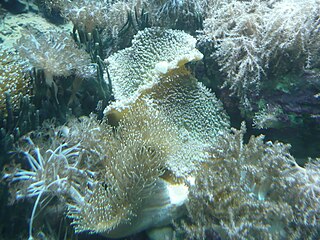
The Scyphozoa are an exclusively marine class of the phylum Cnidaria, referred to as the true jellyfish. It may include the extinct fossil group the Conulariida, whose affinities are uncertain and widely debated.

Tube-dwelling anemones or ceriantharians look very similar to sea anemones but belong to an entirely different class of anthozoans. They are solitary, living buried in soft sediments. Tube anemones live inside and can withdraw into tubes, which are composed of a fibrous material made from secreted mucus and threads of nematocyst-like organelles known as ptychocysts. Ceriantharians were formerly classified in the taxon Ceriantipatharia along with the black corals but have since been moved to their own class, Ceriantharia.

Bubble-tip anemone is a species of sea anemone in the family Actiniidae. Like several anemone species, E. quadricolor can support several anemonefish species, and displays two growth types based on where they live in the water column, one of which gives it the common name, due to the bulbous tips on its tentacles.

Stichodactyla gigantea, commonly known as the giant carpet anemone, is a species of sea anemone that lives in the Indo-Pacific area. It can be kept in an aquarium but is a very challenging species to keep alive and healthy for more than 3–5 years.

Corallimorphus is a genus of colonial anthozoans similar in appearance to sea anemones and in body format to scleractinian stony corals. These animals are cnidarians in the family Corallimorphidae. Members of the genus live off the Pacific coast of the US.
Ptychodactis is a genus of sea anemones. It is the only genus in the monotypic family Ptychodactinidae.

Epiactis is a genus of sea anemones in the family Actiniidae. There are about nineteen recognised species and the type species is Epiactis prolifera.

Metridium farcimen is a species of sea anemone in the family Metridiidae. It is commonly known as the giant plumose anemone or white-plumed anemone. It is found in the eastern Pacific Ocean from Alaska down to Catalina Island, California.

Heteractis malu, also known as the malu anemone, delicate sea anemone or white sand anemone, is a species of sea anemone in the family Stichodactylidae.

Amplexidiscus fenestrafer, also known as the elephant ear anemone, is a species of coral belonging to the phylum Cnidaria. The name "elephant ear anemone" is a misnomer because it is actually a species of coral. It is the only species in the monotypic genus Amplexidiscus.

Haliclystidae is a family of stalked jellyfish in the order Stauromedusae.

Daphne Gail Fautin is an American professor of invertebrate zoology at the University of Kansas, specializing in sea anemones and symbiosis. She is world-renowned for her extensive work studying and classifying sea anemones and related species. A large sea anemone-like cnidarian species has been named in her honor, originally called Boloceroides daphneae, but recently renamed to Relicanthus daphneae, after it was discovered to belong to a previously unknown cnidarian order. Fautin has published numerous scientific articles and texts—including co-authoring Encyclopædia Britannica's entry on cnidarians—and her publications have been widely cited by other researchers in the field. Among her current positions, she is the curator of the University of Kansas Natural History Museum and serves as vice president and commissioner of the International Commission on Zoological Nomenclature, overseeing the naming of new species.
Corallimorphus niwa is a species of corals in the genus Corallimorphus. It was classified by Fautin in 2011. Corallimorphus niwa lives in marine habitats.

Diadumene is a genus of sea anemones. It is the only genus in the monotypic family Diadumenidae.

Edwardsiella is a genus of sea anemones in the family Edwardsiidae. It is named in honour of Henri Milne-Edwards, an eminent French zoologist.
Epiactis lisbethae, commonly known as Lisbeth's brooding anemone, is a species of sea anemone in the family Actiniidae. It is similar in appearance to the common brooding anemone, and like it is native to shallow waters on the western coast of North America.
Epiactis fernaldi, commonly known as the Fernald brooding anemone, is a species of sea anemone in the family Actiniidae. It is native to shallow waters around the San Juan Islands off the western coast of North America.

Poralia is a genus of jellyfish in the family Ulmaridae. It is a monotypic genus containing a single species, Poralia rufescens. This jellyfish is pelagic, and is found in deep water in most of the world's oceans.

Manania handi is a species of stalked jellyfish found in the Pacific Ocean along the west coast of North America. This species can be found in shallow waters at low tide on soft substrates such as seagrass (Phyllospadix), but the related M. gwilliami have also been recovered at depths of >10 metres. This may reflect that intertidal specimens represent the fringes of a population that is typically more commonly found in the subtidal zone.
Manania gwilliami is a species of stalked jellyfish found in intertidal and subtidal zones on the west coast of North America. The stalk (peduncle) is described as being as long or longer than the calyx; the calyx typically has mottled pigmentation throughout. The name "gwilliami" refers to G.F. Gwilliam who described a number of stauromedusae in the mid-20th century.















